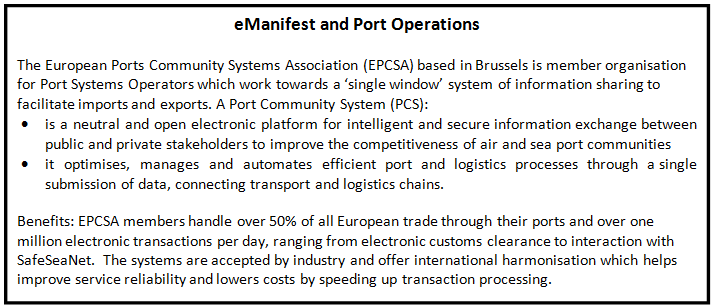

Intermodal freight involves the movement of loads using a combination of transport modes – shipping, inland waterways, rail, road and air. This ideally involves the use of standardised shipping containers - of which there are approximately 17 million worldwide. The negative environmental impacts is increasingly a problem of road freight particularly in long-distance and international operations. The increased volumes of freight crossing the oceans has led to more widespread use containers. This combination of factors has evolved into a new model of freight distribution – where the aim is to limit use of road transport to the last, short link, with the long-distance shipment being carried by more environmentally friendly modes. The advantage of intermodal freight is that aeroplanes, ships, railways and canals can take the lion’s share of long-distance freight flows, whilst keeping the flexibility of road transport for local and regional distribution.
Road Network Operators can benefit from modal shift if this leads to a reduction in heavy freight movements and overloaded vehicles. This is because of reductions in slower moving vehicles contributing to congestion and reduced damage to road infrastructure. Complete removal of long distance road freight is not plausible – nevertheless the European Union in its White Paper on Transport (2011) has set a target of 50% of all road freight to be shifted to more sustainable modes.
ITS plays an important part in helping enabling this to happen. ITS is at the heart of developments in intermodal freight - whether through improved efficiency and throughput of cargo terminals, better tracking of different loads internationally throughout the intermodal transport chain or simply by improving the speed and ease of border crossings.
Asset tracking, end-to-end asset tracking and eManifests enable loads to be processed far more swiftly than previously. Information about the order in which containers are entering the terminal can be transmitted in advance, ensuring that a handling plan can be set up in advance. This improves efficiency - containers or loads can be quickly moved from inbound arrival to outbound departure points without long layovers whilst their details are checked and the load’s path through the terminal is planned.
These movements can be very quick, with a 100 container train being stripped and reloaded within 90 minutes:
Such reliable, quick turnaround times make railfreight increasingly attractive to operators, as the processing time is minimised and vehicles can be used more productively.

Hams Hall Distribution Park, UK
Increasingly, as countries across the globe seek to minimise their environmental impact, road freight is being replaced, where possible, by more sustainable modes. (See Intermodal Freight) Containerisation means that it is now very easy to transport the load by a combination of inland waterway, sea, road and rail. Through the use of RFID tags it is possible to track individual containers or the contents within them across all modes - from the factory to final delivery point. Efficiencies obtained from such a detailed understanding of stock movements have significant impacts on supply chain systems. A better knowledge of estimated departure and arrival improves efficiency of distribution and a reduction in the amount of stock at any one time. (See Just-in-Time)This asset-tracking can make a significant difference as the example.
Other innovative solutions, such as GPS enabled solar powered tracking devices, allow active transmission of location data to provide constant load tracking instead of relying on the product passing through fixed monitoring points at known gateways. As GPS becomes increasingly popular within road freight, rail freight companies are also starting to use satellite technology.

Sharing of electronic data is the bedrock on which all ITS solutions are based. To be successful it is important that standards (See ITS Standards) are available to enable interoperability - so that all safety and load information can be seamlessly transferred between countries, operators and regulators.
The eManifest, as an electronic depository of the contents of all trucks, simplifies border clearance, credential checking and terminal processing. It also supports intermodal transport operations providing the transport operators and shippers in the intermodal chain with access to the same documentation. This facilitates an unbroken journey between transport providers and between transport modes.
eManifests provide operators and the emergency services with access to much needed data - without having to rely on paper copies which may be damaged, lost, or only held within the vehicle itself. Emergency response is helped by knowing the contents of any freight vehicle involved in an incident. The eManifest also helps operators maintain good access to data about their current loads and destinations.
